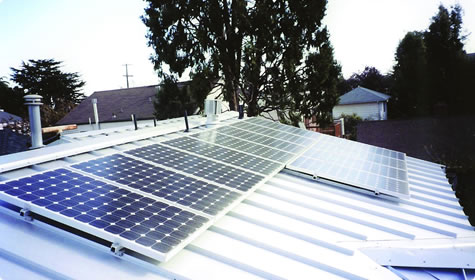 |
 |
 |
Once you've taken the basic steps to reduce your energy bills—insulating, sealing air leaks, installing energy efficient lights, and many of the other energy efficiency improvements we've recommended—what's next?
If you want to think big, consider installing a solar water heating system, a solar electricity system, or both. These technologies use the sun's energy to heat water and power buildings. Solar panels are typically installed on a south-facing roof, although other locations, such as an unshaded area of the property, are sometimes used.
Wind energy systems are also available for residential electricity generation, but are still relatively uncommon compared to photovoltaic systems.
Renewable energy systems are expensive to purchase and install, although rebates and tax credits can help bring these upfront costs down. And since these technologies lower your electricity and water heating costs, over time most systems will pay for themselves.
There are also benefits beyond your bottom line. If you install a renewable energy system, you'll be doing a good turn for the environment by reducing the greenhouse gas emissions associated with your household's energy consumption.
Solar water heating
Solar water heating systems (also known as solar thermal systems) use solar panels and water storage tanks to collect and store heat from the sun. Solar water heating systems are typically used in combination with a standard water heater so that the home has hot water even when the sun isn't shining.
Solar water heating is more cost effective than ever, as a result of new technologies, reliable products and rising energy prices. Many solar water heating systems can provide all the hot water a household needs during summer months, and a large portion of it during the rest of the year. For many households, these energy savings can offset the cost of the system in less than ten years.
Solar hot water systems can be used for both hot water and space heating. See our GreenPointer on Heating and Cooling for more information about space heating systems that use hot water.
Purchase only solar water heaters that are certified by the Solar Rating and Certification Corporation (SRCC). Solar energy suppliers can help you determine if you have sufficient south-facing roof area for the collectors, if the roof structure can accommodate the system's weight, and if there is adequate area near the conventional water heater for additional mechanical equipment such as storage tanks, pumps, pipes and controllers.
Solar electric (photovoltaic) systems
Photovoltaic (PV) systems convert solar energy into electricity when sunlight strikes the PV cells. Most residential systems are grid connected; when the PV system is providing more power than the home uses, additional electricity is fed back into the utility grid. This effectively spins the home's electricity meter backward in what is known as net metering.
When the sun is not shining or when the home requires more electricity than the PV system can produce, the home draws power from the grid. If there is a power outage, a home with a grid-connected PV system will lose power just like homes without PV systems. Adding battery back-up to the PV system is expensive but allows the homeowner to keep some electrical systems running during power outages.
Depending on the size system that is installed and other factors, such as sunlight availability, PV systems can produce enough electricity to offset some or all of a home's electricity use.
For cost and appearance, the best location for PV modules is flush on south-or west-facing roofs. South-facing modules produce more energy annually, but west-facing modules can take better advantage of time-of-use rates that are available from some utilities, and help reduce the electricity grid's peak load.
If you plan to re-roof a tile or metal roof, special PV products are available that are designed to blend in well with the existing roof (they're sometimes referred to as building-integrated photovoltaics). For other roof types, the PV panels are typically mounted on specially designed roof racks that anchor to the home's rafters. If there is unshaded space on the property, another option is to mount PV panels on poles, trellises, carports or other structures.
More renewable energy tips
-
Money back and more. For more information about renewable energy basics, cash rebates and other incentives, go to the California Energy Commission's website, www.consumerenergycenter.org or to www.energyupgradeca.org.
-
Wind turbines. Residential wind energy systems are still rare but may make sense in certain situations. Wind energy can be converted into electricity through the use of a wind turbine on your property. The wind turns two or three turbine blades around a rotor, which is connected to a shaft and spins a generator. The generator converts mechanical power (which the wind turbine converted from kinetic wind energy) into electricity.
Residential wind turbines can make sense in areas with average annual wind speeds of at least 10 miles per hour. To determine wind speeds for an area, go to www.windpoweringamerica.gov/wind_maps.asp. Wind power, though intermittent, can help reduce electricity costs for grid-connected homes. For homes on remote sites, the cost of installing a wind turbine may be less than the cost of running a power line from the grid. As electricity costs increase, wind energy may be increasingly cost competitive with grid energy.